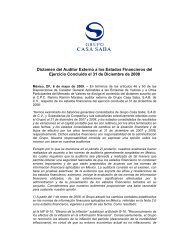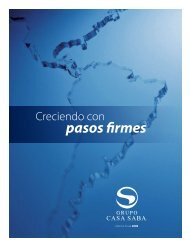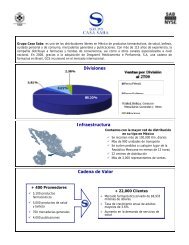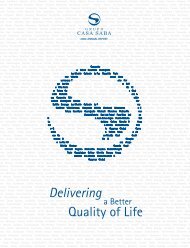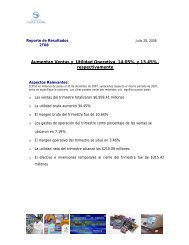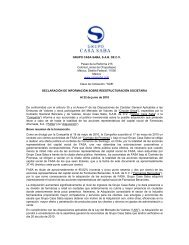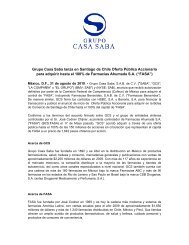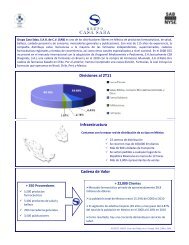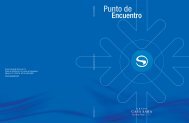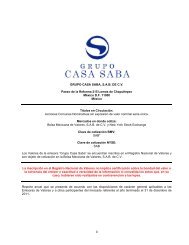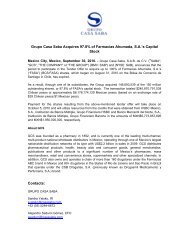FORM 20-F Grupo Casa Saba, S.A.B. de C.V.
FORM 20-F Grupo Casa Saba, S.A.B. de C.V.
FORM 20-F Grupo Casa Saba, S.A.B. de C.V.
Create successful ePaper yourself
Turn your PDF publications into a flip-book with our unique Google optimized e-Paper software.
Table of Contents<br />
Un<strong>de</strong>r ASU <strong>20</strong>11-05 an entity has the option to present the total of comprehensive income, the components of net income, and the components of other comprehensive income either in<br />
a single continuous statement of comprehensive income or in two separate but consecutive statements. In both choices, an entity is required to present each component of net income<br />
along with total net income, each component of other comprehensive income along with a total for other comprehensive income, and a total amount for comprehensive income. In a<br />
single continuous statement, the entity is required to present the components of net income and total net income, the components of other comprehensive income and a total for other<br />
comprehensive income, along with the total of comprehensive income in that statement. In the two-statement approach, an entity is required to present components of net income and<br />
total net income in the statement of net income. The statement of other comprehensive income should immediately follow the statement of net income and inclu<strong>de</strong> the components of<br />
other comprehensive income and a total for other comprehensive income, along with a total for comprehensive income.<br />
ASU <strong>20</strong>11-05 should be applied retrospectively. For public entities it is effective for fiscal years beginning after December 15, <strong>20</strong>11. Early adoption is permitted. Management is in the<br />
process of evaluating the impact that adopting ASU <strong>20</strong>11-15 will have on the Company's financial statements.<br />
● ASU <strong>20</strong>11-08 “Intangible-Goodwill and Other (Topic 350): Testing Goodwill for Impairment (ASU <strong>20</strong>11-08)<br />
Un<strong>de</strong>r ASU <strong>20</strong>11-08, an entity has the option to first assess qualitative factors to <strong>de</strong>termine whether the existence of events or circumstances leads to a <strong>de</strong>termination that it is more<br />
likely than not that the fair value of a reporting unit is less than its carrying amount. If, after assessing the totality of events or circumstances, an entity <strong>de</strong>termines it is not more likely<br />
than not that the fair value of a reporting unit is less than its carrying amount, then performing the two-step impairment test is unnecessary. However, if an entity conclu<strong>de</strong>s otherwise,<br />
then it is required to perform the first step of the two-step impairment test by calculating the fair value of the reporting unit and comparing the fair value with the carrying amount of the<br />
reporting unit, as <strong>de</strong>scribed in paragraph 350-<strong>20</strong>-35-4. If the carrying amount of a reporting unit exceeds its fair value, then the entity is required to perform the second step of the<br />
goodwill impairment test to measure the amount of the impairment loss, if any, as <strong>de</strong>scribed in paragraph 350-<strong>20</strong>-35-9. Un<strong>de</strong>r ASU <strong>20</strong>11-08, an entity has the option to bypass the<br />
qualitative assessment for any reporting unit in any period and proceed directly to performing the first step of the two-step goodwill impairment test. An entity may resume performing<br />
the qualitative assessment in any subsequent period.<br />
ASU <strong>20</strong>11-08 is effective for annual and interim goodwill impairment tests performed for fiscal years beginning after December 15, <strong>20</strong>11. Early adoption is permitted. Management is in<br />
the process of evaluating the impact that adopting ASU <strong>20</strong>11-15 will have on the Company's financial statements.<br />
Item 6.<br />
Directors, Senior Management and Employees<br />
Board of Directors<br />
The following table sets forth the names of our directors, their dates of birth, their principal occupations, their business experience, including other directorships, and<br />
the number of years of service they have as directors. All of these individuals were elected by our sharehol<strong>de</strong>rs at our annual sharehol<strong>de</strong>rs’ meeting, which was held on April 27, <strong>20</strong>12.<br />
Directors<br />
Name and Date of Birth Principal Occupation Business Experience First Elected<br />
Manuel <strong>Saba</strong> A<strong>de</strong>s<br />
(11/03/67)<br />
Chairman of the Board<br />
Director – Xtra Inmuebles, S.A. <strong>de</strong> C.V. and<br />
of <strong>Grupo</strong> <strong>Casa</strong> <strong>Saba</strong>, S.A.B. <strong>de</strong><br />
C.V. Member of the Board of <strong>Grupo</strong> Xtra<br />
S.A., <strong>de</strong> C.V. and of Ixe <strong>Grupo</strong> Financiero,<br />
S.A.B. <strong>de</strong> C.V.<br />
April <strong>20</strong>09<br />
Alberto <strong>Saba</strong> A<strong>de</strong>s<br />
(07/09/65)<br />
Vice Chairman of the Board<br />
Director – Xtra Inmuebles, S.A. <strong>de</strong> C.V.<br />
Chairman of the Board of <strong>Grupo</strong> Xtra, S.A.<br />
<strong>de</strong> C.V.<br />
February <strong>20</strong>00<br />
89



